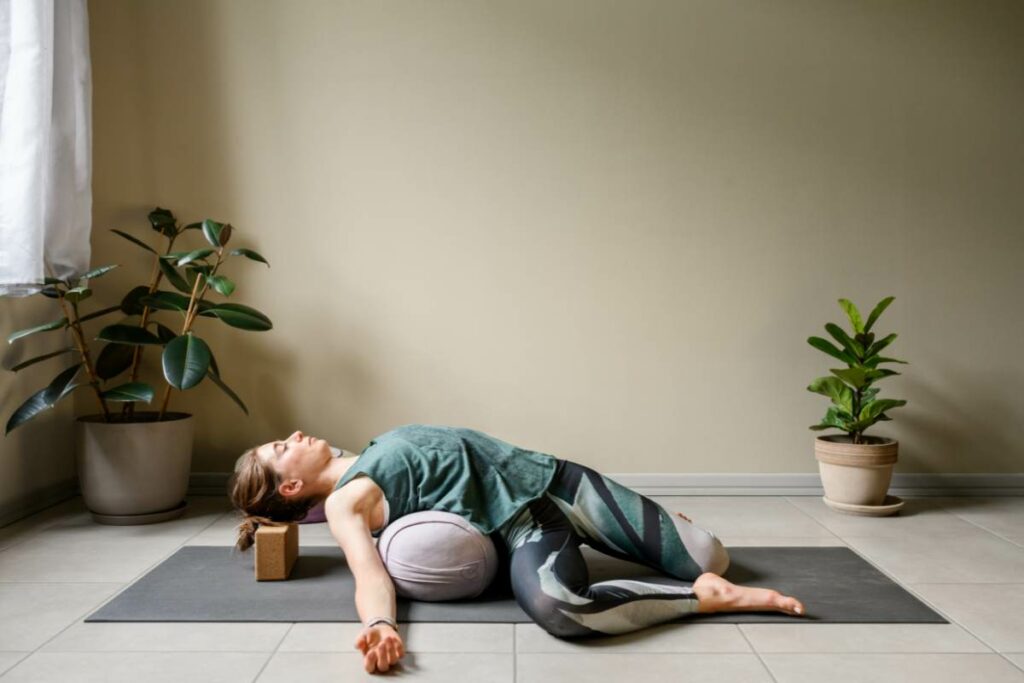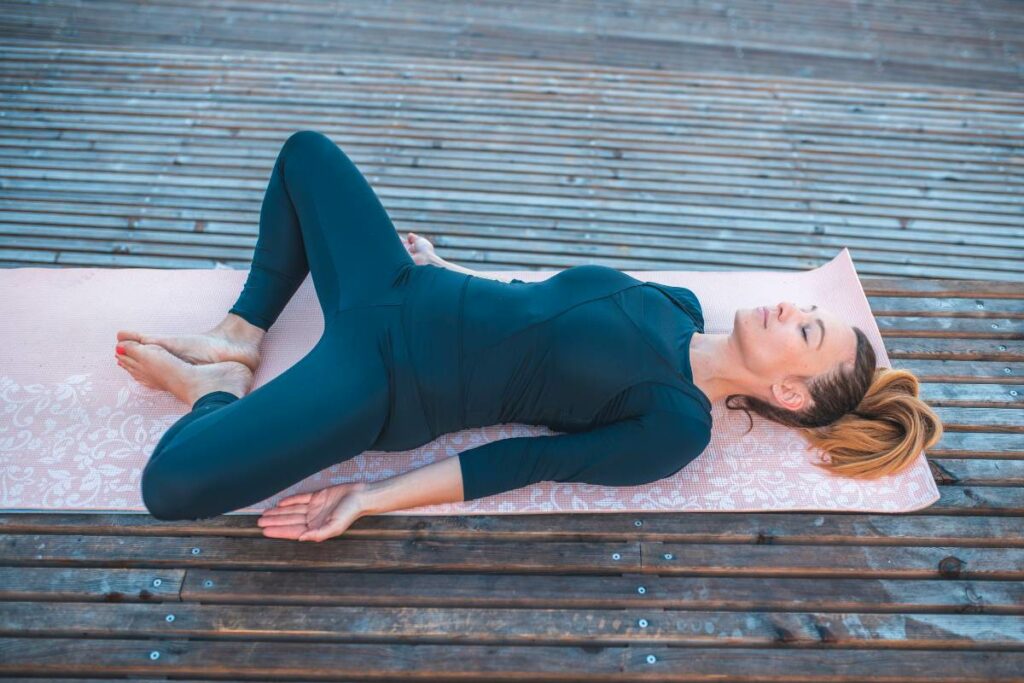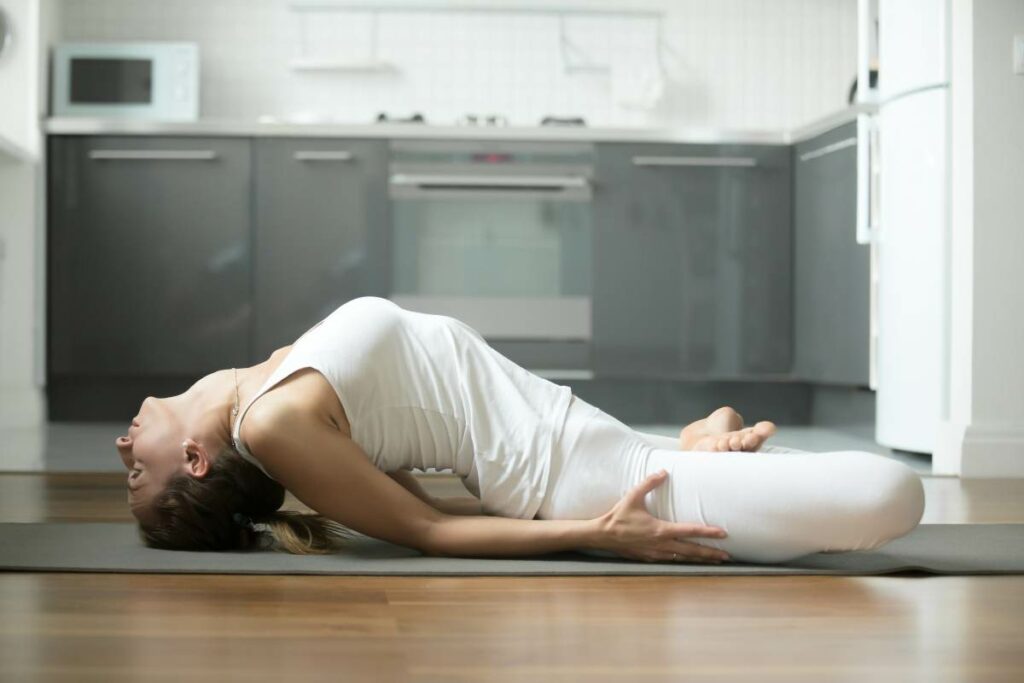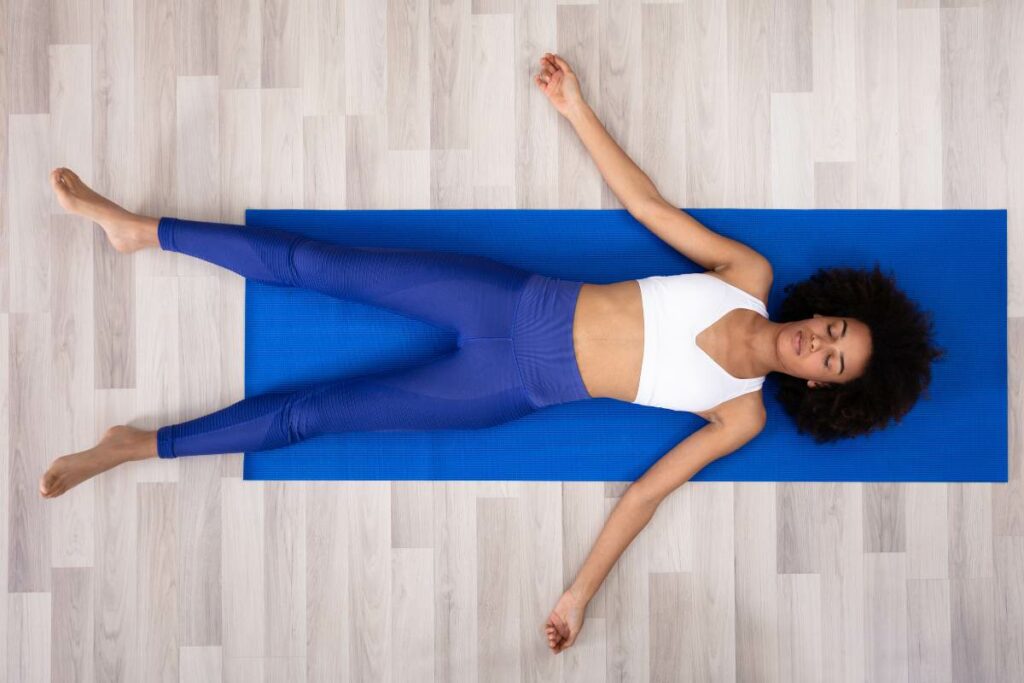Understanding Somatic Exercise: Enhancing Body Awareness and Well-being
Have you ever stumbled upon a video of somatic exercises on social media and wondered what it’s all about?
You’re not alone. With an increasing number of people turning to holistic health practices, somatics is gaining attention for its unique approach to enhancing physical and mental well-being.
Originating from the Greek word “soma,” meaning “the living body,” somatics offers a fascinating way to tune into your body’s needs and capabilities.

This post may contain affiliate links, which helps keep this content free. Please read our disclosure for more info.
What is Somatics?
Somatics, a term that might sound complex at first, is actually your golden ticket to a world where body awareness takes center stage.
Imagine a practice that doesn’t just aim for the superficial goals of muscle gain or flexibility but goes deeper, touching the very essence of how you feel and move through life.
This unique field sits at the crossroads of bodywork and movement studies, shining a spotlight on what it means to truly listen to and understand your body from the inside out.
In contrast to the outward focus of traditional exercise routines and the symptom-based approach of conventional physical therapy, somatics invites you on an inward journey.
It’s not about achieving a specific look or pushing through discomfort to see results. Instead, somatics nurtures an intimate dialogue with your body.
By tuning into your internal experiences—how your muscles relax or tense, the subtlety of your breath, the way your joints move—you start to cultivate a deeper awareness of your physical self.
This inward focus is revolutionary. It shifts the narrative from doing to being, from external validation to internal exploration.
Through somatics, you learn to observe your body’s signals and cues with curiosity and compassion.
This practice doesn’t just skim the surface; it dives into the depths of your sensory experiences, unraveling patterns of tension and movement that you’ve carried, perhaps unconsciously, for years.
The beauty of somatics lies in its ability to foster a profound connection between your mind and body. By becoming deeply attuned to your body’s sensations and movements, you open up a space where healing and growth can occur.
This connection empowers you to move through life with greater ease, resilience, and presence, transforming your relationship with your body in the most beautiful way.
The Principles of Somatics

Taking a look at the core of somatics reveals a trinity of principles that form the foundation of this transformative practice: body awareness, the mind-body connection, and movement reeducation.
Each principle is a vital thread in the fabric of somatics, weaving together to create a holistic approach to well-being that transcends conventional physical training methods.
Body Awareness:
This principle is the cornerstone of somatics. It’s about cultivating a keen sensitivity to the nuances of your body’s language.
Body awareness goes beyond simply noticing discomfort or pleasure; it involves an intricate process of tuning in to the subtle cues and whispers of your body.
Through practices like mindful movement and focused attention, you learn to decode these signals, gaining insights into your body’s needs, limitations, and potential.
This heightened awareness is your first step toward self-healing and improving physical autonomy.
The Mind-Body Connection:
Somatics rests on the understanding that the mind and body are not separate entities but deeply interconnected facets of your being.
This principle recognizes that emotional, mental, and physical health are inextricably linked, influencing and reflecting each other.
Stress, for example, can manifest as physical tension, just as physical discomfort can affect your emotional state.
By fostering a strong mind-body connection, somatics encourages a holistic approach to health, where mental and physical practices support and enhance one another, leading to a more balanced and integrated self.
Movement Reeducation:

The final principle focuses on the concept of learning—or, more accurately, relearning—how to move.
Many of us carry inefficient, restrictive, or even harmful movement patterns that have developed over years of habit, injury, or emotional holding.
Movement reeducation in somatics is about identifying these patterns and gently guiding the body toward more natural, fluid, and efficient ways of moving.
This process often involves retraining the nervous system, allowing for the release of chronic tension and the discovery of new movement possibilities.
The result is not just improved physical function but a sense of liberation and ease in one’s body.
Together, these principles form a powerful approach to personal well-being.
By listening to your body, fostering the mind-body connection, and reeducating your movements, somatics offers a path to not only enhance movement efficiency but also reduce stress and alleviate chronic pain.
This holistic, attentive, and compassionate approach to bodywork empowers individuals to break free from harmful patterns and discover a more fluid, efficient, and harmonious way of living in their bodies.
Popular Somatic Practices
Stepping into the world of somatics, you’ll discover a rich landscape of practices, each with its unique flavor and approach to enhancing body awareness and well-being.
Let’s take a closer look at some of the most popular somatic practices and what makes each of them stand out.
Alexander Technique:
Imagine a method that teaches you to move through life with ease and poise, realigning your posture and transforming the way you perform everyday activities.
That’s the Alexander Technique. It’s not just about standing straighter; it’s about relearning how to use your body in a more relaxed and efficient way.
By identifying and unlearning habitual patterns of tension that may lead to pain and inefficiency, the Alexander Technique offers a path to greater ease of movement, improved balance, and enhanced performance in all areas of life.
Feldenkrais Method:
Named after its founder, Moshe Feldenkrais, this method takes a gentle yet powerful approach to improving movement and function. Through a series of movements called “Awareness Through Movement” lessons or hands-on “Functional Integration” sessions, the Feldenkrais Method helps you explore new movement patterns that increase flexibility, reduce pain, and enhance overall physical function.
It’s an exploratory journey that not only changes how you move but also how you feel in your body, promoting a sense of fluidity and ease in everyday life.
Hanna Somatics:
Developed by Thomas Hanna, Hanna Somatics directly addresses the way chronic stress and response to life’s pressures result in muscle tension and reduced freedom of movement.
This practice focuses on the concept of “somatic education,” teaching you to regain conscious control of your muscles through specific exercises.
By reeducating the nervous system, Hanna Somatics aims to release chronic muscle tension, reverse pain patterns, and improve mobility and posture, leading to increased physical comfort and ease of movement.
Body-Mind Centering:

This integrative approach to body awareness goes deep, exploring the dynamic relationship between body and mind through movement, touch, voice, and mind-body exercises.
Developed by Bonnie Bainbridge Cohen, Body-Mind Centering dives into the anatomy, physiology, and embryological foundations of the body to uncover new pathways of movement and consciousness.
It’s a holistic practice that fosters a profound connection with the body’s inherent wisdom, offering insights into the subtle nuances of bodily experience and promoting a sense of wholeness and well-being.
Each of these practices, with their unique techniques and benefits, provides a different path to achieving greater body awareness, improved physical health, and a deeper connection between mind and body.
Whether you’re drawn to the precise alignment focus of the Alexander Technique, the gentle exploratory movements of the Feldenkrais Method, the muscular reeducation of Hanna Somatics, or the deep embodiment practices of Body-Mind Centering, you’ll find a somatic practice that resonates with your personal journey toward health and well-being.
Benefits of Somatic Practices
Integrating somatic practices into your daily routine opens up a world of benefits that touch every aspect of your life, from the physical to the psychological.
The advantages of adopting this mindful approach to movement and body awareness extend far beyond the obvious, offering transformative effects that can significantly enhance your quality of life.
Physical Health and Mobility:
At the forefront, somatics offers remarkable improvements in physical health. By focusing on posture, it teaches you to carry your body in a way that reduces strain and promotes efficiency in movement.
This realignment can alleviate common aches and pains, leading to a significant decrease in physical discomfort.
Furthermore, the gentle, exploratory nature of somatic exercises increases flexibility and mobility, allowing your body to move more freely and with less effort.
Stress Reduction and Mental Clarity:
The benefits of somatics also extend deeply into mental and emotional well-being. The practice encourages a state of calm awareness and presence, providing a powerful antidote to the stresses of daily life.
This heightened state of mindfulness can lead to reduced anxiety, lower stress levels, and an overall sense of mental clarity.
By fostering a deeper connection between mind and body, somatics helps you navigate life’s challenges with greater resilience and equanimity.
Enhanced Body Awareness:
One of the most profound benefits of somatics is the development of an intimate understanding of your body’s cues and needs.
This awareness allows you to recognize early signs of tension or misalignment and address them before they become problematic.
It also promotes a more harmonious relationship with your body, as you learn to appreciate its capabilities and respond to its limitations with compassion and understanding.
Emotional Balance and Well-being:
The practice of somatics is not just about physical posture and movement; it’s also about emotional posture and the ability to move through emotional states with grace.
By integrating the mind and body, somatics offers a pathway to emotional balance, helping you to manage emotions more effectively and experience a greater sense of well-being.
Improved Performance and Creativity:
For those engaged in sports, arts, or any performance-based activities, somatics can be a game-changer.
The enhanced body awareness and efficiency of movement can lead to improvements in performance, whether you’re an athlete looking to refine your technique or an artist seeking greater expressiveness.
Additionally, the mental clarity and focus fostered by somatic practices can unlock new levels of creativity and problem-solving abilities.
Incorporating somatic practices into your life means more than just physical exercises; it’s about embracing a philosophy of mindful movement and awareness that enriches every facet of your existence.
Imagine navigating your day with reduced tension, moving with grace and efficiency, and experiencing a profound connection to your body.
The power of somatics lies in its ability to transform not just how you move, but how you live.
Expanding Your Body Awareness: Somatic Exercises Across Different Practices

Exploring somatic practices deepens your understanding and connection with your body. Each technique offers unique exercises aimed at enhancing body awareness, reducing tension, and improving movement.
Here are five exercises from each of the popular somatic practices to get you started:
Alexander Technique Exercises:
- Chair Work: This exercise involves the simple yet profound action of sitting down and standing up, performed with deliberate mindfulness. Pay close attention to how you engage your muscles and joints during the process, seeking to minimize unnecessary effort. The goal is to discover a way of moving that feels smoother and more natural, enhancing ease in everyday activities.
- Whispered Ah: A gentle exercise focusing on the relaxation of vocal and respiratory systems. By softly whispering the sound “ah,” you encourage relaxation in the voice, throat, and respiratory muscles. This practice not only promotes vocal ease but also helps in reducing tension in the upper body, contributing to a sense of overall relaxation and well-being.
- Floor Work: In this exercise, you lie on the floor with your knees bent and your head supported, creating an opportunity to let go of tension. The supportive surface of the floor allows you to fully surrender the weight of your body, especially targeting the release of tightness in the back and neck. This practice is beneficial for anyone seeking to alleviate stress and improve posture through relaxation.
- Mirror Work: Utilizing a mirror as a tool for self-observation, this exercise helps you become aware of your habitual posture and alignment. By watching yourself in the mirror, you can gently adjust and refine your posture, aiming for a state of balance and alignment that feels both efficient and comfortable. This visual feedback is invaluable for learning to maintain a healthier, more supportive posture in daily life.
- Hand on the Back of the Chair: This involves placing one hand on the back of a chair and using it as a focal point for exploring movement. The contact with the chair provides a reference point that helps you become more aware of your balance and the distribution of your weight. As you gently shift and move, you can discover new ways of standing and moving that bring greater ease and fluidity to your body’s posture and movements. This exercise is particularly useful for improving stability and ease in standing and walking.
Feldenkrais Method Exercises:
- Pelvic Clock: This imaginative exercise uses the concept of a clock beneath your pelvis to guide movement. By envisioning the pelvis as the center of a clock face, you gently tilt and rotate your pelvis towards each numeral, from 12 to 6, and around the clock. This not only enhances pelvic mobility but also deepens your awareness of this crucial area, affecting posture and balance.
- Eyes and Head Coordination: In this exercise, the focus is on dissociating the movements of your eyes and head, enhancing their coordination. By moving your eyes in one direction while turning your head in the opposite, you challenge and improve the flexibility of your neck muscles. This practice also supports the development of smoother, more integrated movements between these parts, beneficial for overall neck health and reducing tension.
- Spinal Twists: While lying on your back with knees bent, this exercise involves gently rolling your knees side to side, initiating a twisting motion along the spine. This movement encourages spinal flexibility, helps in releasing built-up tension along the back, and promotes a sense of relaxation throughout the body. It’s a simple yet effective way to nurture spinal health and mobility.
- Toe Play: Engage in playful exploration by moving each toe individually, either while sitting or lying down. This exercise is designed to increase your awareness and control over your toes, enhancing foot dexterity and mobility. Such focused attention on the toes can also contribute to improved balance and a deeper connection to the ground during movement.
- Reaching and Rolling: Extend one arm overhead, lying on your back, and initiate a gentle rolling motion of your head and shoulders towards that extended arm. This exercise stretches and explores the range of motion in your shoulders, arms, and upper back, encouraging a greater sense of freedom and fluidity in the upper body.
It’s particularly useful for anyone looking to improve upper body mobility and ease tension in the shoulders and neck.
Hanna Somatics Exercises:

- Arch and Flatten: While lying on your back with knees bent and feet flat on the floor, engage in a fluid movement of arching your lower back away from the floor, then gently flattening it against the floor. This exercise focuses on creating awareness within the spine and back muscles, helping you tune into and release patterns of tension that may contribute to discomfort or rigidity in the back area.
- Pandiculation: Begin by consciously tightening or contracting a specific muscle group, then slowly releasing the tension, allowing the muscle to lengthen and relax fully. This process, akin to a luxurious stretch upon waking, is effective in reducing muscular tension and enhancing muscular function. It teaches the nervous system to regain control over the muscles, leading to improved muscle relaxation and function.
- Side Bend: While lying on your side, engage in a controlled lifting and lowering of your top leg, maintaining a focus on the sensations along the side of your body. This exercise not only targets side-body flexibility but also heightens your awareness of the often-neglected lateral muscles, contributing to a more balanced sense of bodily alignment and movement.
- Diagonal Arch and Curl: From a lying position, initiate an arching and curling motion diagonally across your body by reaching one arm and the opposite leg away from each other and then drawing them in towards each other. This movement pattern enhances both coordination and flexibility, encouraging a deeper connection between various parts of the body and fostering a sense of integrated, whole-body movement.
- Head and Neck Differentiation: In a comfortable lying or sitting position, gently rotate your head from side to side, ensuring the rest of your body remains still and relaxed.
This exercise is designed to increase the mobility and awareness of the neck, encouraging a distinction in movement between the head and the rest of the body.
It’s particularly beneficial for those looking to alleviate neck stiffness and improve the range of motion in the cervical spine.
Body-Mind Centering Exercises:
- Breath and Sound Exploration: This exercise invites you to use your breath as a vehicle for sound, exploring how different sounds resonate within your body.
By consciously altering pitch, volume, and tone, notice how each variation affects your body’s internal landscape. This practice not only enhances vocal resonance but also promotes a deeper connection between your voice and bodily sensations, enriching your sense of self-expression and internal harmony. - Embodied Anatomy: Select a specific body part and focus your attention on moving it, while simultaneously visualizing its internal structure—bones, muscles, tendons, and ligaments. Feel the movement from within, as if you could animate each part of the anatomy with your mind. This deep dive into the body’s internal architecture fosters a profound understanding and appreciation of your body’s complexity and capability, enhancing your movement’s quality and awareness.
- Fluid Movement Exploration: Envision your body as a vessel filled with water, and allow this image to guide your movements, emphasizing fluidity and ease. Explore how different parts of your body interact and respond to this imagined fluidity, noticing areas of resistance and ease. This exercise encourages a holistic sense of flow and connection throughout the body, breaking down stiffness and promoting a seamless integration of movement.
- Grounding and Centering: In a standing or sitting position, visualize roots extending from the soles of your feet or your sitting bones deep into the earth. This mental imagery aims to enhance your physical and emotional sense of stability and presence. As you visualize grounding, notice how your body responds, perhaps feeling more anchored and centered. This practice is invaluable for cultivating a foundation of calm and resilience in both body and mind.
- Touch and Connect: With gentle, mindful touches, explore different parts of your body, paying close attention to the sensations that arise. Notice the quality of touch—its warmth, pressure, and texture—and how it affects your awareness of the body part being touched. This exercise deepens the connection between tactile sensation and body awareness, fostering a heightened sense of presence and unity within the body.
Through these touches, you’re invited to explore the landscape of your body with curiosity and care, nurturing a compassionate and integrated body-mind relationship.
Integrating these exercises into your daily routine can open new pathways to body awareness, movement efficiency, and overall well-being.
Remember, the goal is to explore these movements with curiosity and attention, allowing the unique wisdom of your body to guide your practice.
Embracing Somatics: A Pathway to Enhanced Well-being and Self-Discovery

Somatics stands out as a profoundly transformative approach to health and well-being, centering on the vital practice of attuning to and learning from the body’s wisdom.
This journey into somatic practices illuminates a path toward not merely improved physical efficiency but also a significant reduction in stress levels and a cultivation of a deeper, more intuitive connection with one’s own body.
By incorporating somatic exercises into your life, you engage in a process of self-discovery and self-care that transcends traditional fitness paradigms.
This is not about achieving external goals but about nurturing an internal dialogue with your body. It’s a practice that teaches you to honor your body’s signals, to move with mindfulness and ease, and to appreciate the intricate ways in which your body communicates its needs and capacities.
The benefits of somatic practices extend beyond the immediate physical improvements; they ripple outwards, enhancing mental clarity, emotional resilience, and a sense of groundedness in one’s life.
As you learn to move with greater awareness and less effort, you may find yourself navigating daily challenges with more grace and flexibility, both metaphorically and literally.
Somatics encourages a holistic view of health, where the mind and body are seen as interconnected aspects of your being.
This integrated approach fosters a comprehensive sense of wellness, where physical health is in harmony with mental and emotional well-being.
In embracing somatic practices, you’re not just adopting a new set of physical exercises; you’re opening yourself to a philosophy of living that values the wisdom of the body and the power of mindful presence.
Whether you’re seeking to alleviate physical discomfort, reduce stress, or simply cultivate a deeper connection with yourself, somatics offers a rich, rewarding pathway to achieving these goals.
As you continue to explore and integrate somatic practices into your daily routine, remember that the journey is as important as the destination.
Each step, each breath, and each movement is an opportunity to deepen your understanding of yourself and to live more fully in your body. Somatics is not just a practice but a way of being, one that invites continuous exploration, learning, and growth.

